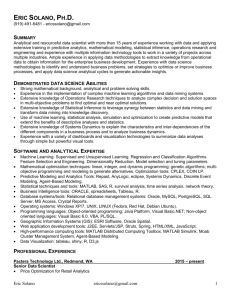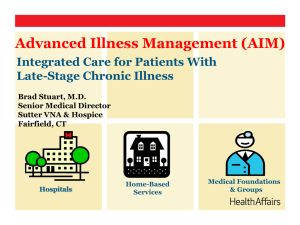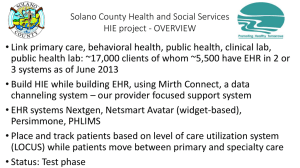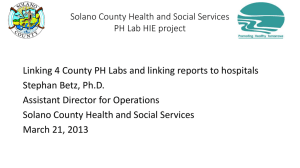2013 – 2015 Implementation Strategy
advertisement
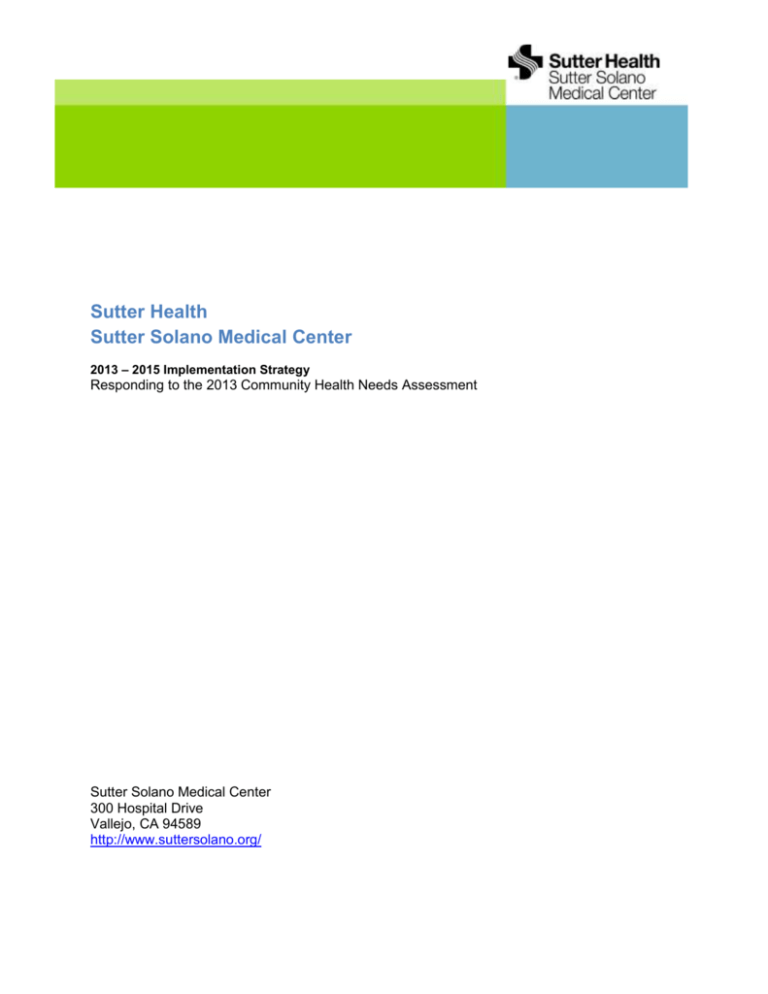
Sutter Health Sutter Solano Medical Center 2013 – 2015 Implementation Strategy Responding to the 2013 Community Health Needs Assessment Sutter Solano Medical Center 300 Hospital Drive Vallejo, CA 94589 http://www.suttersolano.org/ Table of Contents Introduction ........................................................................................................................ 3 About Sutter Health ........................................................................................................... 3 2013 Community Health Needs Assessment Summary .................................................. 4 Definition of Community Served by the Hospital ....................................................... 4 Significant Health Needs Identified ........................................................................... 6 2013 – 2015 Implementation Strategy ............................................................................... 8 Lack of preventative services and community programs & Limited access to follow-up treatment and specialty care ..................................................................................... 9 Transportation ........................................................................................................ 13 Needs Sutter Solano Medical Center Plans Not to Address ......................................... 14 Approval by Governing Board ........................................................................................ 15 2 Sutter Solano Medical Center, Implementation Strategy 2013 - 2015 Introduction This implementation strategy describes how Sutter Solano Medical Center, a Sutter Health affiliate, plans to address significant needs identified in the Community Health Needs Assessment (CHNA) published by the hospital on October 5, 2013. The document describes how the hospital plans to address identified needs in calendar (tax) years 2013 through 2015. The 2013 CHNA and this implementation strategy were undertaken by the hospital to understand and address community health needs, and in accordance with proposed Internal Revenue Service (IRS) regulations pursuant to the Patient Protection and Affordable Care Act of 2010. This implementation strategy addresses the significant community health needs described in the CHNA that the hospital plans to address in whole or in part. The hospital reserves the right to amend this implementation strategy as circumstances warrant. For example, certain needs may become more pronounced and merit enhancements to the described strategic initiatives. Alternately, other organizations in the community may decide to address certain community health needs, and the hospital may amend its strategies and refocus on other identified significant health needs. Beyond the initiatives and programs described herein, the hospital is addressing some of these needs simply by providing health care to the community, regardless of ability to pay. About Sutter Health Sutter Solano Medical Center is affiliated with Sutter Health, a not-for-profit network of hospitals, physicians, employees and volunteers who care for more than 100 Northern California towns and cities. Together, we’re creating a more integrated, seamless and affordable approach to caring for patients. The hospital’s mission is to enhance the health and well-being of people in the communities we serve, through a not-for-profit commitment to compassion and excellence in health care services. Vision Sutter Health leads the transformation of health care to achieve the highest levels of quality, access and affordability. Values Excellence and Quality Caring and Compassion Honesty and Integrity Teamwork Community At Sutter Health, we believe there should be no barriers to receiving top-quality medical care. We strive to provide access to excellent health care services for Northern Californians, regardless of ability to pay. As part of our not-for-profit mission, Sutter Health invests millions of dollars back into the communities we serve – and beyond. Through these investments and community partnerships, we’re providing and preserving vital programs and services, thereby improving the health and well-being of the communities we serve. In 2012, our network of physician organizations, hospitals and other health care providers invested $795 million (compared to $756 million in 2011) in health care services for low-income people, community health improvement services, and other community benefits. For more facts and information about Sutter Solano Medical Center, please visit http://www.suttersolano.org/ 3 Sutter Solano Medical Center, Implementation Strategy 2013 - 2015 2013 Community Health Needs Assessment Summary Every three years nonprofit hospitals are required to conduct community health needs assessments (CHNA) and use the results of these to develop community health improvement implementation plans. These requirements are imposed on virtually all non-profit hospitals by both state and federal laws. Beginning in early 2012 through February 2013, Valley Vision, Inc. completed an assessment of the health needs of residents living in the Solano County Health Service Area (HSA). For the purposes of the assessment, a health need was defined as: “a poor health outcome and its associated driver.” A health driver was defined as: “a behavioral, environmental, and/or clinical factor, as well as more upstream social economic factors, that impact health.” The objective of the CHNA was to provide necessary information for Kaiser Permanente’s, NorthBay Healthcare’s, and Sutter Health Sacramento Sierra Region’s community health improvement plans, identify communities and specific groups within these communities experiencing health disparities, especially as these disparities relate to chronic disease, and further identify contributing factors that create both barriers and opportunities for these populations to live healthier lives. The full 2013 Community Health Needs Assessment report conducted by Sutter Solano Medical Center is available at http://www.sutterhealth.org/communitybenefit/community-needs-assessment.html Definition of Community Served by the Hospital The study area of the assessment was Solano County. A key focus was to show specific communities (defined geographically) experiencing disparities as they relate to chronic disease and mental health. To this end, ZIP code boundaries were selected as the unit-of-analysis for most indicators. This level of analysis allowed for examination of health outcomes at the community level that are often hidden when data are aggregated at the county level. Some indicators (demographic, behavioral, and environmental in nature) were included in the assessment at the census tract level, the census block, or point prevalence, which allowed for deeper community level examination. The HSA was designated as all of Solano County because all three healthcare systems serve communities within the county and, as a key partner in this assessment and eventual implementation, the Solano Coalition for Better Health maintains close relationships with the healthcare systems involved. The HSA identified to be the focus of the needs assessment is depicted in Figure 2 in the full report. The first step in the process of identifying vulnerable communities was to examine socio-demographics in order to identify areas of the HSA with high vulnerability to chronic disease disparities and poor mental health outcomes. Race and ethnicity, household makeup, income, and age variables were combined into a vulnerability index that described the level of vulnerability of each census tract. This index was then mapped for the entire HSA. A tract was considered more vulnerable, or more likely to have higher negative or unwanted health outcomes than others in the HSA, if it had higher: 1) percent Hispanic or Non-White population; 2) percent single parent headed households; 3) percent population below 125% of the poverty level; 4) percent population under five years old; and 5) percent population over 65 years of age living in the census tract. This information was used in combination with input from the CHNA workgroup to identify prioritized areas for which key informants 4 Sutter Solano Medical Center, Implementation Strategy 2013 - 2015 would be sought. To identify Communities of Concern, input from the CHNA team and primary data from key informant interviews and focus groups, along with detailed analysis of secondary data, health outcome indicators, and socio-demographics were examined. ZIP codes with rates that consistently exceeded county, state, or Healthy People 2020 benchmarks for ED utilization, hospitalization, and mortality were considered. ZIP codes that consistently fell in the top 20% highest rates were noted and then triangulated with primary and socio-demographic data to identify specific Communities of Concern. The Communities of Concern are clustered in the Vallejo, Fairfield, and Vacaville areas along the I-80 corridor. In terms of population density, these represent the major population centers of the Solano County HSA. The Rio Vista area Communities of Concern are located in the southeastern portion of the county adjacent to the Delta area and are considered more rural. Socio-demographic conditions, commonly referred to as social determinants of health, help predict which communities in a broad geographic area are most susceptible to poor health outcomes. Table 4 below describes the socio-demographic profile of each community of concern for the Solano County HSA. The six ZIP codes identified are home to nearly one-quarter million residents. Data indicated that these areas of the HSA were highly diverse and demonstrated a large number of areas with high rates of poverty, low educational attainment, high unemployment, high uninsured rates, and a high number of residents renting versus owning their homes. In all six ZIP codes, at least 29.4% of residents reported as either Hispanic or non-White. In ZIP codes within Vallejo and Fairfield, 66.4% or more reported as Hispanic or non-White. The percent of residents over the age of five with limited English proficiency (LEP) was relatively low, ranging from 3.7% to 6.4%. ZIP codes 94571, 94589, and 94590 displayed high percentages of poverty in specific areas. In Rio Vista, 94571, 53.8% of single femaleheaded households were living in poverty, which exceeded the national average of 31.2%. Two ZIP codes in Vallejo, 94589 and 94590, had a higher percent of residents over age 65 living in poverty compared to the national benchmark. The percent of families with children living in poverty in 94590 was 19.5%, which exceeded the national benchmark of 15.1%. Five out of the six area ZIP codes had a higher percent of residents over the age of 25 who did not possess a high school diploma compared to the national benchmark. All but one of the ZIP codes had a higher rate of unemployment compared to the national rate, while two had a higher percent uninsured compared to the national rate at 16.3%. Looking at the percentage of individuals within a ZIP code who rent versus own their place of residence provides a peak into a community’s health and financial stability. The percent of residents who rent in the six ZIP codes identified as Communities of Concern ranged from 27.0% to 54.6%. 5 Sutter Solano Medical Center, Implementation Strategy 2013 - 2015 Significant Health Needs Identified The following significant health needs were identified by the 2013 CHNA. Significant Community Health Need Limited access to healthy foods Farmers’ markets and healthy food can be expensive, high number of fast food places in lower income neighborhoods, busy schedules make it difficult to prepare meals, and cultural diets may not be healthy Personal safety Parks may not be safe to visit at night, illicit drug sales on streets, and overall perception that a neighborhood or area is unsafe Lack of or limited access to health education Need for more classes and services to educate residents about maintaining their health and/or managing chronic health conditions, may help avoid a health condition becoming a crisis Intends to Address No No Yes Limited access to follow-up treatment and specialty care Difficulty getting referrals through Medi-Cal, Medi-Cal reimbursements are too low, residents are diagnosed with a condition but lack the financial resources to obtain care Yes Transportation Public transit may not have stops near healthcare or social services, clients may not have a car or ability to pay for gas. More route and bus stop location issues in the urban; simple lack of transit and transit that does not go out of town in the rural areas. Yes Lack of or limited access to dental care Medi-Cal no longer covers dental services and paying for services is too expensive Yes Limited access to medications and prescription drugs Prescriptions and co-pays are expensive so residents go without or have to space apart dosages Yes Limited places to walk, bike, exercise, or play Neighborhood connectivity, sidewalks, bicycle routes, and parks may not be present in certain neighborhoods. Poor street design and urban planning in the urban and lack of sidewalks or streets where cars go too fast in rural areas. No Limited places and social space for civic engagement City planning and built environment, street design aspects that limit walkability, and healthy public spaces where community can interact, fast food locations may act as social space to meet Lack of preventive services and community programs Many city or park programs charge a fee, budget cuts have limited public service availability, exercise classes and gym membership are expensive 6 No Yes Sutter Solano Medical Center, Implementation Strategy 2013 - 2015 Prioritization of health needs occurred at two levels: 1) identification of high risk geographical areas within each HSA, and 2) determination of health needs (defined as behavioral, environmental, and/or clinical factors, as well as more upstream social economic factors, that impact health outcomes). First, within the HSA specific Communities of Concern were identified through the analysis of data collected from key informant interviews, focus group interviews, health outcome indicators, and socio-demographic indicators (see Appendix B). This step identified specific communities within the larger HSA that were at higher risk for negative health outcomes disproportionately to the overall HSA, as well as subgroups within Communities of Concern that experienced these health disparities. Health needs were identified through the examination of health behavior and environmental data, as well as qualitative data pertaining specifically to the Communities of Concern. Upon identification of a health need, examination of data which spoke to corresponding health outcomes and related sociodemographical influences on that health need were noted in the health needs table (Appendix G in the full report). A health need was considered a higher priority based on the number of times key informants and focus group participants pointed to the severity of the identified need, and the degree to which the quantitative data supported the findings. 7 Sutter Solano Medical Center, Implementation Strategy 2013 - 2015 2013 – 2015 Implementation Strategy This implementation strategy describes how Sutter Solano Medical Center plans to address significant health needs identified in its 2013 Community Health Needs Assessment and consistent with its charitable mission. The strategy describes: Actions the hospital intends to take, including programs and resources it plans to commit; Anticipated impacts of these actions and a plan to evaluate impact; and Any planned collaboration between the hospital and other organizations. 8 Sutter Solano Medical Center, Implementation Strategy 2013 - 2015 Lack of preventative services and community programs & Limited access to follow-up treatment and specialty care Name of Program, Initiative or Activity The Transitional Care Program (TCP) Description The Transitional Care Program (TCP) provides a place to discharge and connect homeless patients, who are traditionally underserved residents, with resources and support. SSMC, along with other local health providers, offer funding and support to the Solano Coalition for Better Health and the Benicia Community Action Coalition, to provide this program to some of Solano County’s most vulnerable residents. This program links homeless adults to vital community services while giving them a place to heal, as well as medical follow up and case management. The clients who are enrolled in the TCP are individuals who otherwise would be discharged to the street or cared for in an inpatient setting only. In addition, the TCP allows patients to focus on recovery and developing a long-term plan to get off the streets, all while being linked to vital community and medical services. The TCP has produced impressive client outcomes by providing “wraparound” services including connection to a medical home, enrollment in eligible programs and support services for clients. Anticipated Impact and Plan to Evaluate TCP has a strong track record of improving access to care for uninsured, medically indigent people residing in Solano County. SSMC will continue to evaluate the impact of these programs on a quarterly basis, by tracking the number of people served, number of linkages to other referrals/services and other indicators, and by assessing the community’s access to preventative services, community programs and follow-up treatment in its next Community Health Needs Assessment. In addition to addressing the lack of access to primary and preventative services, the TCP also addresses lack of or limited access to health education and helps link patients to the appropriate medications and prescription drugs. Name of Program, Initiative or Activity SSMC Emergency Department Navigator Description The Emergency Department Navigator program seeks to connect with patients who are inappropriately accessing care at the Sutter Solano Medical Center Emergency Department and links all non-urgent users of the ED to immediate community resources and medical care. More specifically, ED Navigators reach out to patients who do not have a primary care provider and provide external management, connection to 9 Sutter Solano Medical Center, Implementation Strategy 2013 - 2015 services (e.g. insurance enrollment, substance abuse treatment, etc.) and follow up to ensure a primary care provider is being utilized. ED Navigators are employees of La Clincia, but are supported through funding from SSMC and reside in the Sutter Solano Medical Center Emergency Department. Additionally, we recently expanded this program to include a Certified Application Assistant, who works alongside the ED Navigator in the Emergency Room and provides education, outreach and insurance enrollment services for the patients who need it. Anticipated Impact and Plan to Evaluate Since its inception, the ED Navigator program has a strong track record of improving access to care for uninsured, medically indigent people residing in Solano County. SSMC will continue to evaluate the impact of these programs on a quarterly basis, by tracking the number of people served, number of linkages to other referrals/services and other indicators, and by assessing the community’s access to preventative services, community programs and follow-up treatment in its next Community Health Needs Assessment. In addition to addressing the lack of access to primary and preventative services, the ED Navigator program also addresses lack of or limited access to health education and helps link patients to the appropriate medications and prescription drugs. Name of Program, Initiative or Activity Investment in La Clinica Description Investment in Federally Qualified Health Centers (FQHC’s) throughout the Sutter Health Sacramento Sierra Region is imperative to the health and wellbeing of our communities as we prepare for Affordable Care Act implementation in 2014. As a result, SSMC has provided strategic investments in La Clinica, Vallejo North, to increase their capacity to serve the underinsured. La Clinica serves a key partner in Solano County, as they provide care to some of the most vulnerable populations in our region. By continuing to invest in this important health center, we are ensuring the underserved have access to care and a medical home. La Clínica North Vallejo is located across the parking lot from Sutter Solano Medical Center and offers primary medical care, health education, social services and behavioral health services to residents of Solano County and surrounding areas. La Clinica is a full service urgent care health center that serves diverse patients from the Sutter Solano Emergency Department and provides medical procedures beyond traditional primary care including suturing, incision and drainage, casting, and much more. Their goal is to provide quality, patient-centered health information, education and clinical care to all members of the community regardless of economic, insurance, or cultural barriers. La Clinica 10 Sutter Solano Medical Center, Implementation Strategy 2013 - 2015 accomplishes this through collaborative, innovative programs, services and referral resources to meet the economic needs of the entire community. In addition to primary and mental health care services, La Clinica offers, physical exams, immunizations, pap smears, nutrition and fitness promotion, management of chronic illnesses, laboratory testing, smoking cessation and prescriptions and pharmacy assistance program. La Clinica North Vallejo also provides urgent care, family planning services (including, pregnancy testing and referrals, birth control and safe sex education, diagnosis and treatment of sexually-transmitted and other infections and HIV testing) behavioral health care services (including grief counseling, crisis intervention, case management linkage & referrals, counseling support/education groups) and specialty care services. La Clinica Dental also offers dental exams for children, cleaning and polishing, crown and bridge, full and partial dentures, emergency treatment (including extractions, restorations amalgam, composite) fluoride and sealant treatment and general dentistry. By investing in La Clinica and supporting this tremendous organization’s growth and innovative efforts, we are able to address multiple priority needs in effective and impactful ways. In addition to addressing the lack of access to preventative services and community programs, as well as limited access to follow-up treatment and specialty care, SSMCs investment in La Clinica also helps tackle the community’s need for access to health education, lack of preventive services and community programs, and limited access to medications and prescription drugs. Anticipated Impact and Plan to Evaluate We work closely with the staff and leadership of La Clinica to measure the impact of this important FQHC’s work. The La Clinica North Vallejo programs and expansion efforts have proven to expand access to care for the underinsured, medically indigent people residing in the greater Solano community. SSMC will continue evaluate the impact of La Clinica, by tracking the number of people served, number of linkages to other referrals and services and other indicators, and by assessing the community’s access to care needs in its next Community Health Needs Assessment. Name of Program, Initiative or Activity Free Mammogram Screening Program Description Throughout the month of October, Sutter Diagnostic Imaging centers across the SHSSR Region provide free digital screening mammograms to uninsured women in honor of National Breast Cancer Awareness Month. The goal of this outreach effort was to not only provide free 11 Sutter Solano Medical Center, Implementation Strategy 2013 - 2015 screenings to underinsured women in our communities, but it also serves as an opportunity to provide women with information on health and insurance resources. Free mammograms are offered in various locations, at various times, including in two locations in Solano County, to ensure as many women as possible were able to take advantage of this effort. In addition, a packet of follow up resources was created in the event that a participant had an abnormal screening, as well as insurance enrollment services. Sutter Diagnostic staff was also given resources to provide to women who needed diagnostic follow up and/or treatment. In 2012, as a result of all of the crucial Breast Cancer Awareness efforts, SHSSR provided a total of 670 free and low-cost mammograms. Our goal is not only to screen uninsured women, but we also use these events as a connection point to the underserved members of our community, to link them with a primary care provider and follow up resources if needed, as well as insurance enrollment information. We will have to examine the current model of this program in 2014, as under the Affordable Care Act, all women (with the exception of undocumented immigrants) will have insurance; therefore, we will reassess our process moving forward, as these events have typically targeted the uninsured only. Anticipated Impact and Plan to Evaluate 12 SSMC will continue evaluate the impact of our Free Mammography Screenings on an annual basis, by tracking the number of people served and by assessing the community’s access to care needs in its next Community Health Needs Assessment. We will also reexamine this program with a critical eye in 2014, to ensure it evolves with the needs of the community after the implementation of the ACA. Sutter Solano Medical Center, Implementation Strategy 2013 - 2015 Transportation Name of Program, Initiative or Activity Solano County Intercity Paratransit Service Description Solano County is in the process of creating an Intercity Paratransit Service that would provide rides for some of the most vulnerable and underserved in our community. Sutter Solano Medical Center has a seat on the Solano Seniors and People With Disabilities Transportation Advisory Committee and regularly hears updates about this important effort, which would help address the lack of transportation in Solano County, as identified by the CHNA. SSMC has expressed interest in serving as a partner in this program and stays in communication with Solano County transportation planning staff and the plan progresses. Anticipated Impact and Plan to Evaluate This plan is in its early phase and will be going to the Board of Supervisors soon for first review. Since this plan is still conceptual, it’s too early to describe the method for assessing impact. Ultimately, if successful, this program would provide door-to-door service for the underserved population in Solano County, allowing them to safely and easily travel to medical appointments and other health care needs. 13 Sutter Solano Medical Center, Implementation Strategy 2013 - 2015 Needs Sutter Solano Medical Center Plans Not to Address No hospital can address all of the health needs present in its community. Sutter Solano Medical Center is committed to serving the community by adhering to its mission, using its skills and capabilities, and remaining a strong organization so that it can continue to provide a wide range of community benefits. This implementation strategy does not include specific plans to address the following significant health needs that were identified in the 2013 Community Health Needs Assessment: Limited access to healthy foods: Not only is there a lack of effective interventions to address this need, this is not something that we are able to greatly affect through community benefit; therefore, we are focusing our resources elsewhere. Personal safety: This is primarily a law enforcement issue and not something that SSMC has the expertise to effectively address. Limited places to walk, bike, exercise, or play: This is primarily an issue that needs to be reviewed by the city/county planning and parks and recreation departments and is not something that SSMC has the expertise or resources to effectively address. Limited places and social space for civic engagement: This is primarily a city planning and business issue and not something that SSMC has the expertise to effectively address. 14 Sutter Solano Medical Center, Implementation Strategy 2013 - 2015 Approval by Governing Board This implementation strategy was approved by the Governing Board of Sutter Solano Medical Center on November 11, 2013. 15 Sutter Solano Medical Center, Implementation Strategy 2013 - 2015



